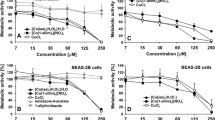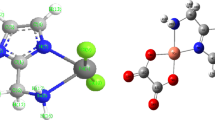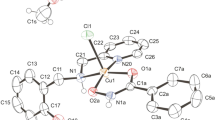Abstract
In an attempt to propose new applications for the biomedical field, complexes with mixed ligands {[Cu(bpy)2(μ2OClO3)]ClO4}n (1) and [Cu(phen)2(OH2)](ClO4)2 (2) (bpy: 2,2′-biyridine; phen and 1,10-phenantroline) were evaluated for their antibacterial and cytotoxicicity features and for the elucidation of some of the mechanisms involved. Complex (2) proved to be a very potent antibacterial agent, exhibing MIC and MBEC values 2 to 54 times lower than those obtained for complex (1) against both susceptible or resistant Gram-positive and Gram-negative strains, in planktonic or biofilm growth state. In exchange, complex (1) exhibited selective cytotoxicity against melanoma tumor cells (B16), proving a promising potential for developing novel anticancer drugs. The possible mechanisms of both antimicrobial and antitumor activity of the copper(II) complexes is their DNA intercalative ability coupled with ROS generation. The obtained results recommend the two complexes for further development as multipurpose copper-containing drugs.











Similar content being viewed by others
References
Amberg DC, Burke DJ, Strathern JN (2005) Measuring yeast cell density by spectrophotometry. In: Burke D, Dawson D, Stearns T (eds) Methods in yeast genetics. A Cold Spring Harbor Laboratory Course Manual, Cold Spring Harbor Laboratory Press, New York, pp 163–165
ASTM F 756-00 (2000) Standard practice for assessment of hemolytic properties of materials. American Society for Testing of Materials, West Conshohocken
Bacalum M, Janosi L, Zorila F, Tepes A-M, Ionescu C, Bogdan E, Hadade N, Craciun L, Grosu I, Turcu I, Radu M (2017) Modulating short tryptophan-and arginine-rich peptides activity by substitution with histidine. Biochim Biophys Acta Gen Subj 1861:1844–1854. https://doi.org/10.1016/j.bbagen.2017.03.024
Badea M, Uivarosi V, Olar R (2020) Improvement in the pharmacological profile of copper biological active complexes by their incorporation into organic or inorganic matrix. Molecules 25:5830. https://doi.org/10.3390/molecules25245830
Barbinta-Patrascu ME, Badea N, Bacalum M, Ungureanu C, Suica-Bunghez IR, Iordache SM, Pirvu C, Zgura I, Maraloiu VA (2019) 3D hybrid structures based on biomimetic membranes and Caryophyllus aromaticus-"green" synthesized nano-silver with improved bioperformances. Mat Sci Eng C 101:120–137. https://doi.org/10.1016/j.msec.2019.03.069
Bertini I, Grey HB, Stiefel EI, Valentine JS (2007) Biological inorganic chemistry: structure and reactivity. University Science Books, Sausalito
Bradford MM (1974) A rapid and sensitive method for the quantitation of microgram quantities of protein utilizing the principle of protein-dye binding. Anal Biochem 72:248–254. https://doi.org/10.1016/0003-2697(76)90527-3
Cadonia E, Valletta E, Caddeo G, Isaia F, Cabiddu MG, Vascellari S, Pivetta T (2017) Competitive reactions among glutathione, cisplatin and copper-phenanthroline complexes. J Inorg Biochem 173:126–133. https://doi.org/10.1016/j.jinorgbio.2017.05.004
Chikira M, Ng CH, Palaniandavar M (2015) Interaction of DNA with simple and mixed ligand copper(II) complexes of 1,10-phenanthrolines as studied by DNA-fiber EPR spectroscopy. Int J Mol Sci 16:22754–22780. https://doi.org/10.3390/ijms160922754
Chilom CG, Găzdaru DM, Bălăsoiu M, Bacalum M, Stolzar SV, Popescu AI (2017) Biomedical application of biogenic ferrihydrite nanoparticles. Roman J Phys 62:701
Crispini A, Cretu C, Aparaschivei D, Andelescu AA, Sasca V, Badea V, Aiello I, Szerb EI, Costisor O (2018) Influence of the counterion on the geometry of Cu(I) and Cu(II) complexes with 1,10-phenanthroline. Inorg Chim Acta 470:342–351. https://doi.org/10.1016/j.ica.2017.05.064
Culotta VC (2000) Superoxide dismutase, oxidative stress, and cell metabolism. Curr Top Cell Regul 36:117–132. https://doi.org/10.1016/s0070-2137(01)80005-4
Culotta VC, Sturtz LA (2002) Superoxide dismutase null mutants of baker’s yeast, Saccharomyces cerevisiae. Methods Enzymol 349:167–172. https://doi.org/10.1016/s0076-6879(02)49332-9
Dumitru I, Ene CD, Ofiteru AM, Paraschivescu C, Madalan AM, Baciu I, Farcasanu IC (2012) Identification of [CuCl(acac)(tmed)], a copper(II) complex with mixed ligands, as a modulator of Cu, Zn superoxide dismutase (Sod1p) activity in yeast. J Biol Inorg Chem 17:961–974. https://doi.org/10.1007/s00775-012-0912-1
Ferreira BJ, Brandão P, Meireles M, Martel F, Correia-Branco A, Fernandes DM, Santos TM, Félix V (2016) Synthesis, structural characterization, cytotoxic properties and DNA binding of a dinuclear copper(II) complex. J Inorg Biochem 161:9–17. https://doi.org/10.1016/j.jinorgbio.2016.04.026
García-Giménez JL, González-Álvarez M, Liu-González M, Macías B, Borrás J, Alzuet G (2009) Toward the development of metal-based synthetic nucleases: DNA binding and oxidative DNA cleavage of a mixed copper(II) complex with N-(9H-purin-6-yl)benzenesulfonamide and 1,10-phenantroline. Antitumor activity in human Caco-2 cells and Jurkat T lymphocytes. Evaluation of p53 and Bcl-2 proteins in the apoptotic mechanism. J Inorg Biochem 103:923–934. https://doi.org/10.1016/j.jinorgbio.2009.04.003
Gralla EB, Kosman DJ (1992) Molecular genetics of superoxide dismutases in yeasts and related fungi. Adv Genet 30:251–319. https://doi.org/10.1016/s0065-2660(08)60322-3
Gurudevaru C, Gopalakrishnan M, Senthilkumar K, Hemachandran H, Siva R, Srinivasan T, Velmurugan D, Shanmugan S, Palanisami N (2017) Synthesis and structural and DNA binding studies of mono and dinuclear copper(II) complexes constructed with –O and –N donor ligands: potential anti-skin cancer drugs. Appl Organomet Chem 31:e3998. https://doi.org/10.1002/aoc.3998
Hathaway BJ (1987) Oxyanions. In: Wilkinson G, Gillard RD, McCleverty JA (eds) Comprehensive coordination chemistry. Pergamon Press, New York, pp 413–434
Jayamani A, Sengottuvelan N, Kang SK, Kim YI (2015) Mono- and binuclear copper(II) complexes of the bipyridine ligand: structural, electrochemical and biological studies. Polyhedron 98:203–216. https://doi.org/10.1016/j.poly.2015.05.042
Kalinowska-Lis U, Szabłowska-Gadomska I, Lisowska K, Ochocki J, Małecki M, Felczak A (2017) Cytotoxic and antimicrobial properties of copper(II) complexes of pyridine and benzimidazole derivatives. Z Anorg Allg Chem 643:993–998. https://doi.org/10.1002/zaac.201700115
Khatoon Z, McTiernan CD, Suuronen EJ, Mah T-F, Alarcon EI (2018) Bacterial biofilm formation on implantable devices and approaches to its treatment and prevention. Heliyon 4:e01067. https://doi.org/10.1016/j.heliyon.2018.e01067
Lever ABP (1986) Inorganic electronic spectroscopy. Elsevier, Amsterdam
Libardo MDJ, Bahar AA, Ma B, Fu R, McCormick LE, Zhao J, McCallum SA, Nussinov R, Ren D, Angeles-Boza AM, Cotton ML (2017) Nuclease activity gives an edge to host-defense peptide piscidin 3 over piscidin 1, rendering it more effective against persisters and biofilms. FEBS J 284:3662–3683. https://doi.org/10.1111/febs.14263
Ma T, Xu J, Wang Y, Yu H, Yang Y, Liu Y, Ding W, Zhu W, Chen R, Ge Z (2015) Ternary copper(II) complexes with amino acid chains and heterocyclic bases: DNA binding, cytotoxic and cell apoptosis induction properties. J Inorg Biochem 144:38–46. https://doi.org/10.1016/j.jinorgbio.2014.12.011
McGivern PJT, Afsharpour S, Marmion JC (2018) Copper complexes as artificial DNA metallonucleases: from Sigman’s reagent to next generation anticancer agent? Inorg Chim Acta 472:12–39. https://doi.org/10.1016/j.ica.2017.08.043
Monti E, Paracchini L, Piccinini F, Malatesta V, Morazzoni F, Supino R (1990) Cardiotoxicity and antitumor activity of a copper(II)-doxorubicin chelate. Cancer Chemother Pharmacol 25:333–336. https://doi.org/10.1007/BF00686232
Mroueh M, Daher C, Hariri E, Demirdjian S, Isber S, Choi ES, Mirtamizdoust B, Hammud HH (2015) Magnetic property, DFT calculation, and biological activity of bis[(μ2-chloro)chloro(1,10-phenanthroline)copper(II)]complex. Chem Biol Interact 231:53–60. https://doi.org/10.1016/j.cbi.2015.02.023
Nyarko E, Hanada N, Habib A, Tabata M (2004) In vitro toxicity of palladium(II) and gold(III) porphyrins and their aqueous metal ion counterparts on Trypanosoma brucei brucei growth. Chem Biol Interact 148:19–25. https://doi.org/10.1016/j.cbi.2004.03.004
Patel RN, Singh YP, Singh Y, Butcher RJ (2016) Synthesis, crystal structure, DFT computation and bioactivity measurements of copper(II) polypyridyl complexes. Polyhedron 104:116–126. https://doi.org/10.1016/j.poly.2015.11.042
Pivetta T, Trudu F, Valletta E, Isaia F, Castellano C, Demartin F, Tuveri R, Vascellari S, Pani A (2014) Novel copper(II) complexes as new promising antitumour agents. A crystal structure of [Cu(1,10-phenanthroline-5,6-dione)2(OH2)(OClO3)](ClO4). J Inorg Biochem 141:103–113. https://doi.org/10.1016/j.jinorgbio.2014.08.011
Pyle AM, Rehmann JP, Meshoyrer R, Kumar CV, Turro NJ, Barton JK (1989) Mixed-ligand complexes of ruthenium(II): factors governing binding to DNA. J Am Chem Soc 111:3051–3058. https://doi.org/10.1021/ja00190a046
Reum Won A, Kim R, Jung M-J, Kim SK, Lee Y-A (2018) Dependence of the base sequence on the [Cu(2,2’-bipyridine)2(NO3)](NO3)-induced oxidative DNA cleavage probed by linear dichroism. Inorg Chim Acta 471:34–39. https://doi.org/10.1016/j.ica.2017.10.009
Rostas AM, Badea M, Ruţă LL, Farcaşanu IC, Maxim C, Chifiriuc MC, Popa M, Luca M, Čelan Korošin N, Cerc Korošec R, Bacalum M, Răileanu M, Olar R (2020) Copper(II) complexes with mixed heterocycle ligands as promising antibacterial and antitumor species. Molecules 25:3777. https://doi.org/10.3390/molecules25173777
Ruta LL, Popa CV, Nicolau I, Farcasanu IC (2016) Calcium signaling and copper toxicity in Saccharomyces cerevisiae cells. Environ Sci Pollut Res Int 23:24514–24526. https://doi.org/10.1007/s11356-016-6666-5
Santini C, Pellei M, Gandin V, Porchia M, Tisato F, Marzano C (2014) Advances in copper complexes as anticancer agents. Chem Rev 114:815–862. https://doi.org/10.1021/cr400135x
Satyanarayana S, Dabrowiak JC, Chaires JB (1993) Tris(phenanthroline)ruthenium(II) enantiomer interactions with DNA: mode and specificity of binding. Biochemistry 32:2573–2584. https://doi.org/10.1021/bi00061a015
Sherman F (2002) Getting started with yeast. Methods Enzymol 350:3–41. https://doi.org/10.1016/S0076-6879(02)50954-X
Sigman DS, Mazumder A, Perrin DM (1993) Chemical nucleases. Chem Rev 93:2295–2316. https://doi.org/10.1021/cr00022a011
Sun J, Xu H (2010) Synthesis, structures and properties of Cu(II) and Mn(II) complexes with 1,10-phenanthroline-2-carboxylic acid and 2,2’-bipyridine ligands. Molecules 15:8349–8359. https://doi.org/10.3390/molecules15118349
Thati B, Noble A, Creaven BS, Walsh M, Kavanagh K, Egan DA (2007) An in vitro investigation of the induction of apoptosis and modulation of cell cycle events in human cancer cells by bisphenanthroline-coumarin-6,7-dioxacetatocopper(II) complex. Chem Biol Interact 168:143–158. https://doi.org/10.1016/j.cbi.2007.04.003
Trudu F, Amato F, Vaňhara P, Pivetta T, Peña-Méndez EM, Havel J (2015) Coordination compounds in cancer: past, present and perspectives. J Appl Biomed 13:79–103. https://doi.org/10.1016/j.jab.2015.03.003
Wang T, Guo Z (2006) Copper in medicine: homeostasis, chelation therapy and antitumor drug design. Curr Med Chem 13:525–537. https://doi.org/10.2174/092986706776055742
Wehbe M, Leung AWY, Abrams MJ, Orvig C, Bally MB (2017) A perspective—can copper complexes be developed as a novel class of therapeutics? Dalton Trans 46:10758–10773. https://doi.org/10.1039/c7dt01955f
Zelenko O, Gallagher J, Sigman DS (1997) Scission of DNA with Bis(1,10-phenanthroline)copper without intramolecular hydrogen migration. Angew Chem Int Ed Engl 36:2776–2778. https://doi.org/10.1002/anie.199727761
Zhou X, Yang C, Le X, Chen S, Liu J, Huang Z (2004) Synthesis and crystal structures of one-dimensional ClO bridged coordination polymers: {[Cu(Bpy)2(μ2-ClO4)]·ClO4}n and{[Cu2(L-arg)2(Bpy)2(μ2-ClO4)2]·2ClO4·4H2O}n. J Coord Chem 57:401–409. https://doi.org/10.1080/00958970410001689832
Acknowledgements
Authors acknowledge Romanian National Authority for Scientific Research and Innovation, UEFISCDI, for financial support through research projects PDI-PFE-CDI ID 335 "Interdisciplinary Institutional Platform for Excellence in Research, Development, Innovation and Professional Training in Archaeological Sciences (ArchaeoScience # RO)," PCCDI/2018 no. 52, Multidisciplinary and complex platform for the integrative and systematic research of the identity of the tangible and non-tangible cultural heritage of Romania. Subproject 3- New technologies for preservation, conservation, recovering and restoration of the cultural heritage", and PN-III-P4-ID-PCCF-2016-0114 RADAR. For the biocompatibility studies, the work was supported by PN 19 06 02 03/2019. The funding had no role in study design, data collection, analysis, decision to publish, or preparation of the manuscript.
Author information
Authors and Affiliations
Contributions
Conceptualization, RO, MB, ICF and MCC; Data curation, RO, MB, MR, LLR, AMR, IDV and MP; Formal analysis, MB, MB, MR, LLR, ICF, AMR, IDV, MP and MCC; Investigation, RO, MB and MP; Supervision, RO, MB, ICF, AMR and MCC; Writing—original draft, RO; Writing—review and editing, MB, ICF, AMR and MCC. All authors provided essential information in the interpretation of the results, contributed to the writing of the paper, have read and agreed to the published version of the manuscript.
Corresponding author
Ethics declarations
Conflict of interest
The authors declare no conflict of interest.
Additional information
Publisher's Note
Springer Nature remains neutral with regard to jurisdictional claims in published maps and institutional affiliations.
Rights and permissions
About this article
Cite this article
Olar, R., Badea, M., Bacalum, M. et al. Antiproliferative and antibacterial properties of biocompatible copper(II) complexes bearing chelating N,N-heterocycle ligands and potential mechanisms of action. Biometals 34, 1155–1172 (2021). https://doi.org/10.1007/s10534-021-00334-9
Received:
Accepted:
Published:
Issue Date:
DOI: https://doi.org/10.1007/s10534-021-00334-9




